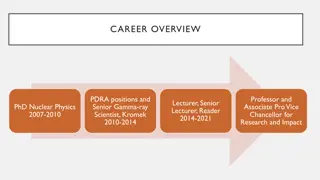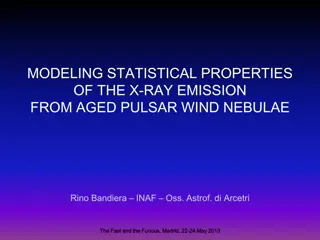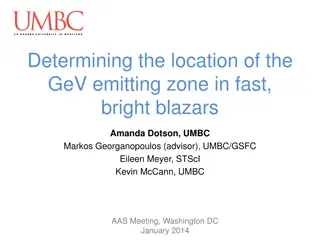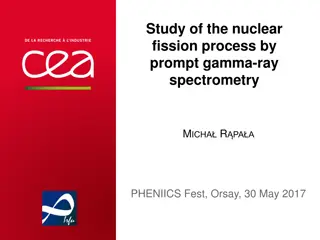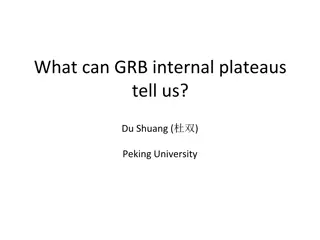Understanding Soft Gamma-Ray Emissions from Pulsar Polar Caps
Soft gamma-ray emissions from the polar cap cascade region are a subject of interest in astrophysics, with studies focusing on the fundamental physical processes of pulsars and potential origins of non-thermal X-ray emissions. Researchers explore the emission processes, polar cap accelerators, cascade processes within pulsars, and emission from the pairs. The study aims to simulate the polar cap cascade, analyze high-energy emissions, and apply findings to MeV pulsars, potentially shedding light on the mysterious GeV quiet soft gamma-ray phenomena.
Download Presentation

Please find below an Image/Link to download the presentation.
The content on the website is provided AS IS for your information and personal use only. It may not be sold, licensed, or shared on other websites without obtaining consent from the author. Download presentation by click this link. If you encounter any issues during the download, it is possible that the publisher has removed the file from their server.
E N D
Presentation Transcript
Soft gamma-ray emissions from the polar cap cascade region Yiyuan Zhu Collaborator: Jumpei Takata
Outline Background and Motivation Model Result Conclusion
Background and Motivation Polar cap cascade is the fundamental physical process of the pulsar No high-energy feature from the polar cap cascade region has been confirmed. Origin of Non-thermal X-Ray is under debate. Could it come from the polar cap region? ? (Aliu et al. 2008+) (Credit: D.J. Thompson (NASA/GSFC))
Spectrum and Pulse profile of the MeV pulsars Spectrum and Pulse profile of the MeV pulsars (Wang et al. 2018) PSR J1617-5055 PSR J1811-1925 PSR J1846-0258 PSR J1930+1852 MeV pulsars may be the evidence of the emission from the polar cap cascade !
Previous model (Wang et al. 2018) Previous work by Wang et al.(2018) suggested that GeV quiet soft gamma-ray is because of the peculiar geometry (Outer gap model). We discuss the possibility that the emission comes from the polar cap cascade region. (Aliu et al. 2008+)
Purpose Simulate the polar cap cascade Study the high-energy emission from the cascade region Application to the MeV pulsars.
Polar cap accelerator Basic idea of the polar cap acceleration: Pulsar dipole magnetic field Potential drop Lorentz factor of the primary particle Size of the polar cap accelerator Ruderman et al. 1975 +
Cascade process in pulsar polar cap Our calculation is based on Timokhin et al. (2018). The difference is that we also calculate the spectrum. The photons that escape from the cascade region make up the spectrum we observe. Timokhin et al. 2018
Emission processes Initial primary particle energy (in units of mec2) -- Curvature radiation About half of the energy would be transferred into CR photons. -- Synchrotron radiation -- Reasonant inverse-Compton scattering(RICS) with the thermal photons from the surface. Emission from the pairs
Assumptions Size of the cascade region. scascde = 2RNS Constant magnetic field Constant curvature radius of the magnetic field Polar cap injects the particles with an Goldreich-Julian rate.
Multiplicity Multiplicity is the number of particles created by one priamry particle. At B~1012 G it reaches the maximum. When magnetic field > 1012G, the mean free path decrease, then the perpendicular momentum decrease. Multiplicity ~105-106for typical parameters of the pulsars.
Luminosity of escaping photons The maximum locates at B~1012G, because synchrotron radiation power decrease with B and NGJincrease with B.
B=1013G B=1012G Spectrum
Compare with the observation of SGR PSR J1617-5055 multiplicity: 1648899 J1617-5055: P=69ms B~3.1x1012G Our simulation could explain the emission of J1617-5055 at 1keV~1MeV. Parameters with scascade=2RNSand c=106cm provides a good fit to the observation.
Conclusion Our work suggests that the soft gamma-ray emissions could come from the cascade process in the pulsar polar cap region. The multiplicity could reach its maximum when B~1012G. And it's higher with lower curvature radius and shorter spinning period. The maximum of luminosity locates at B~1012G. And it's higher with shorter period and higher curvature radius. RICS contributes more to multiplicity in higher magnetic field.
Future plan Extend the model - Extending the cascade simulation for magnetic field > 1013G where Photon splitting becomes important. - Apply the 3D polar cap accelerator model to our simualtion. Confirm the model - Study the emission geometry and compare it with the pulse profile.






